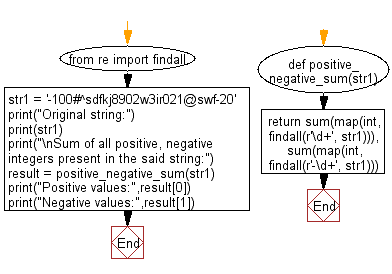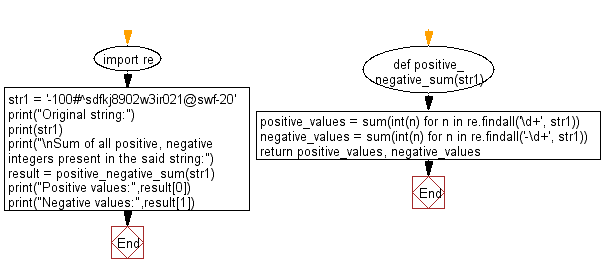Python Challenges: Calculate sum of all positive, negative integers present in a given string
Python Challenges - 1: Exercise-64 with Solution
Write a Python program to calculate sum of all positive, negative integers present in a given string.
Sample Solution-1:
Python Code:
from re import findall
def positive_negative_sum(str1):
return sum(map(int, findall(r'\d+', str1))), sum(map(int, findall(r'-\d+', str1)))
str1 = '-100#^[email protected]'
print("Original string:")
print(str1)
print("\nSum of all positive, negative integers present in the said string:")
result = positive_negative_sum(str1)
print("Positive values:",result[0])
print("Negative values:",result[1])
Sample Output:
Original string: -100#^[email protected] Sum of all positive, negative integers present in the said string: Positive values: 9046 Negative values: -120
Flowchart:

Sample Solution-2:
Python Code:
import re
def positive_negative_sum(str1):
positive_values = sum(int(n) for n in re.findall('\d+', str1))
negative_values = sum(int(n) for n in re.findall('-\d+', str1))
return positive_values, negative_values
str1 = '-100#^[email protected]'
print("Original string:")
print(str1)
print("\nSum of all positive, negative integers present in the said string:")
result = positive_negative_sum(str1)
print("Positive values:",result[0])
print("Negative values:",result[1])
Sample Output:
Original string: -100#^[email protected] Sum of all positive, negative integers present in the said string: Positive values: 9046 Negative values: -120
Flowchart:

Python Code Editor:
Contribute your code and comments through Disqus.
Previous: Write a Python program to reverse and add the numbers of the two linked lists.
What is the difficulty level of this exercise?
Test your Programming skills with w3resource's quiz.
Python: Tips of the Day
Find current directory and file's directory:
To get the full path to the directory a Python file is contained in, write this in that file:
import os dir_path = os.path.dirname(os.path.realpath(__file__))
(Note that the incantation above won't work if you've already used os.chdir() to change your current working directory, since the value of the __file__ constant is relative to the current working directory and is not changed by an os.chdir() call.)
To get the current working directory use
import os cwd = os.getcwd()
Documentation references for the modules, constants and functions used above:
- The os and os.path modules.
- The __file__ constant
- os.path.realpath(path) (returns "the canonical path of the specified filename, eliminating any symbolic links encountered in the path")
- os.path.dirname(path) (returns "the directory name of pathname path")
- os.getcwd() (returns "a string representing the current working directory")
- os.chdir(path) ("change the current working directory to path")
Ref: https://bit.ly/3fy0R6m
- New Content published on w3resource:
- HTML-CSS Practical: Exercises, Practice, Solution
- Java Regular Expression: Exercises, Practice, Solution
- Scala Programming Exercises, Practice, Solution
- Python Itertools exercises
- Python Numpy exercises
- Python GeoPy Package exercises
- Python Pandas exercises
- Python nltk exercises
- Python BeautifulSoup exercises
- Form Template
- Composer - PHP Package Manager
- PHPUnit - PHP Testing
- Laravel - PHP Framework
- Angular - JavaScript Framework
- Vue - JavaScript Framework
- Jest - JavaScript Testing Framework
